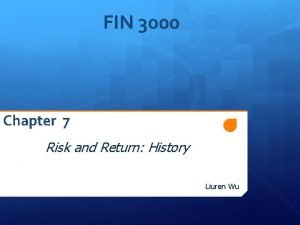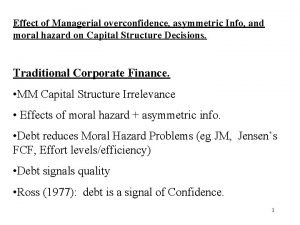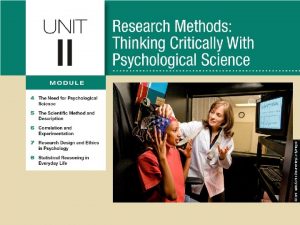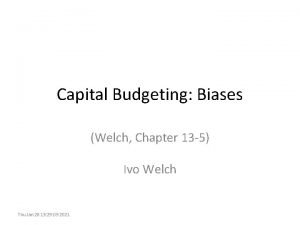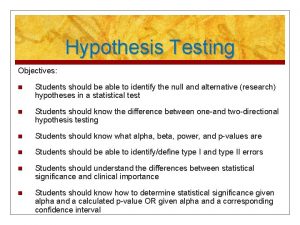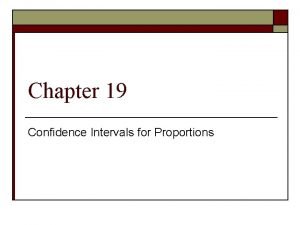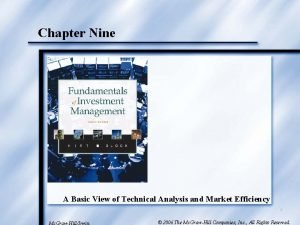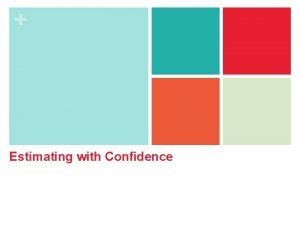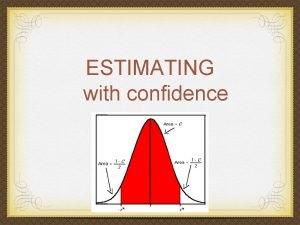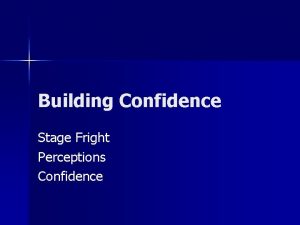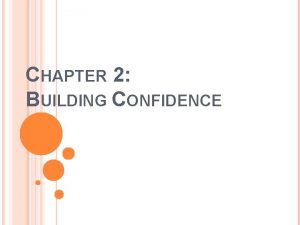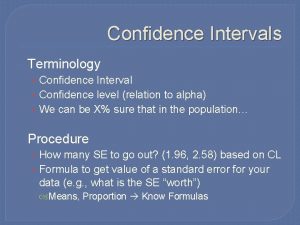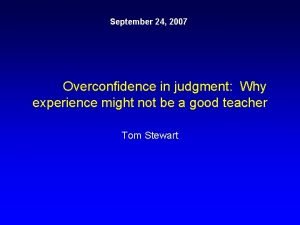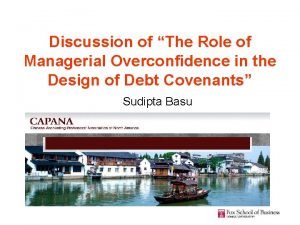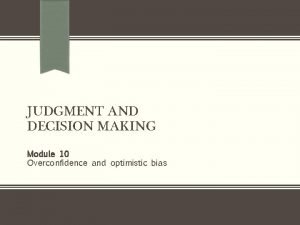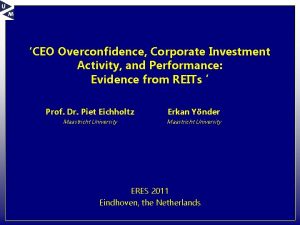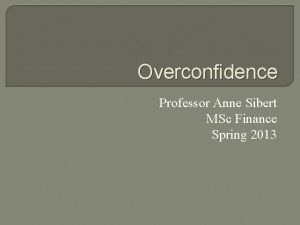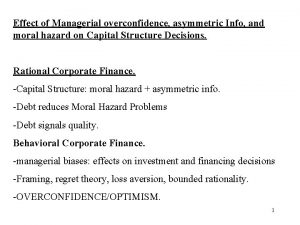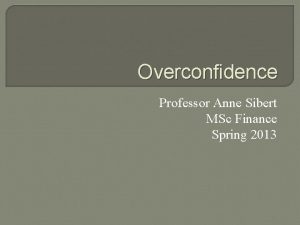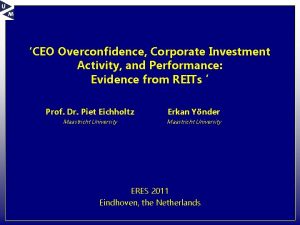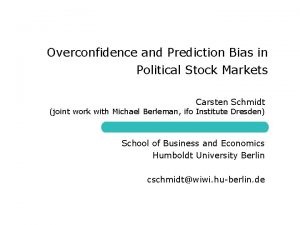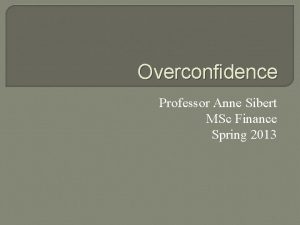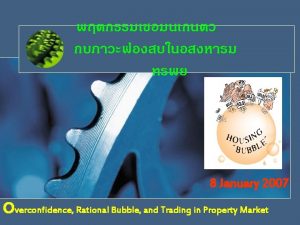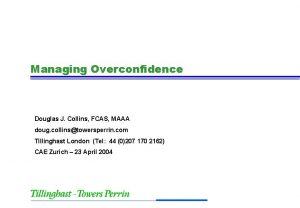Overconfidence 1 Confidence vs overconfidence Confidence is all

























- Slides: 25

Overconfidence 1

Confidence vs. overconfidence • Confidence is all about having a positive feeling about your skills, knowledge, etc. • But overconfidence is when you have an inflated sense of your abilities. • Various manifestations: – – Miscalibration Excessive optimism Better-than-average effect Illusion of control 2

Calibration-based overconfidence • Miscalibration normally implies thinking that your knowledge is more accurate than it really is. • Measured through calibration tests. • Ask people 50 multiple choice questions. – Then ask how many right? And compare the two numbers – If you think you got 25 right…but you only got 15 right – You appear to be overconfident 3

Calibration-based overconfidence cont. • Or use confidence interval approach. • Suppose individuals are asked to construct 90% confidence intervals (e. g. , height of Mount Everest). • A percentage of individuals usually less than 90% usually comes up with intervals that bracket true answer. • This also suggests miscalibration-based overconfidence. 4

Better-than-average effect • Better-than-average effect says that many of us feel we are smarter or more skilled than average. • But only 50% of us can really be better than average. • Evidence suggests that people pick definition of task that suits their purpose. 5

Illusion of control • Reveals itself when people think that they have more control over events than objectively can be true. – For example, gamblers may think that they can control the dice or the cards 6

Excessive optimism • Present when people’s predictions about the future are unrealistically optimistic. • In essence, people assign probabilities to favourable/unfavorable outcomes that are just too high/low given historical experience or reasoned analysis. • Excessive optimism and miscalibration can go hand in hand. – Suppose you purchase a stock – True distribution for the return on this stock over the next year entails an expected return of 10%, with a 90% confidence range of -10% to 30% – You (optimistic) distribution, has expectation of 20%, with a 90% confidence range of 10% to 30% 7

Excessive optimism cont. • Evidence on excessive optimism: – Students expect to receive higher marks than they actually do receive – And they overestimate the number of job offers that they will receive – People often think that they can accomplish more than they actually end of accomplishing • Cost of excessive optimism: – Inability to meet one’s goals can lead to disappointment, loss of self-esteem and reduced social regard – And time and money can be wasted pursuing goals that are unrealistic 8

Problems measuring overconfidence • Most people most of the time appear to be overconfident. • But overconfidence does not seem to be universal. – Underconfidence is common on easy tasks • Also, depending on the metric, it is possible for people to be judged overconfident using one metric but not using another. – And there is no universally accepted way to measure overconfidence 9

Overconfidence and demographics • We are not all equally overconfident. • The greatest offenders are men: – On a survey men and women were asked what they expected the market return and their own portfolio return to be in the following 12 months. • Both men and women expected their portfolios to outperform the market – but gap greater for men • Also evidence that highly educated, highincome people are more overconfident. 10

Why don’t we learn? • Self-attribution bias retards the learning process by allowing us to embellish our triumphs while forgetting our defeats. • Hindsight bias the common tendency for people to perceive events that have already occurred as having been more predictable than they actually were before the events took place. • Confirmation bias may contribute too – this is tendency to search out evidence consistent with one’s prior beliefs and to ignore conflicting data. • These effects suggest that overconfidence can evolve over time. 11

Overconfidence may not be all bad • Research has shown that predictions about the future tend to be more optimistic when: – Goals are far off – A course of action has been committed to • When these conditions are met, excessive optimism may be useful in enhancing performance. 12

The Impact of Overconfidence on Financial Decision-making 13

Overconfidence and excessive trading • Theoretical models indicate a relationship between overconfidence and extent of trading. • To get a flavor, consider 3 investors: – High-OC investor – Low-OC investor – No-OC investor (accepts whatever the market tells him) 14

Overconfidence, excessive trading and demand curves 15

Interpretation • Difference between 3 investors: they respond differently to prices which are different from their value estimates. • Inv. 1 slavishly maintains his holding regardless of price changes: this investor wishes to hold qn at any price. • Other two investors have negatively-sloped demand curves, implying willingness to “march to beat of a different drummer. ” • Inv. 2/3 pays some/most attention to own opinion. 16

Interpretation cont. • Consider what happens as the price changes: – Higher OC leads to more trading for a given value vs. price gap • The more overconfident is the market the greater will be volume at level of market. 17

Do people trade because of knowledge or knowledge perception? • Several related studies documented trading losses that were perhaps attributable to overconfidence. – 60, 000 households during 1991 -96 studied – Looked at gross and net of transaction cost returns – Found that those trading the most frequently earned an average annual return of 11. 4% vs. the market’s 17. 9% – Greatest offenders were men 18

Gross vs. net returns Source: Barber, B. , and T. Odean, 2000, "Trading is hazardous to your wealth: The common stock investment performance of individual investors, " Journal of Finance 55, 773 -806. 19

Overconfidence and excessive trading? • This evidence only indirectly relates trading and overconfidence. – How do we know that it is overconfidence that is driving excessive trading? • Studies from surveys and the lab try to establish direct relationship between overconfidence and trading activity. 20

Survey evidence • Another study combined naturally-occurring data with information obtained from a survey. • Used trading data from online brokerage accounts and psychometric data obtained from same group of investors who responded to an online questionnaire. • Various measures of trading activity were correlated with a number of metrics of overconfidence. • Solid evidence that those who were most subject to better-than-average effect traded the most. 21

Conclusions Overconfident traders traded the most. And performed the worst (not shown in table). Miscalibration was predominant. And better-than-average effect mattered as well. Overconfidence mattered both at individual and market levels (not shown in table). • Other effects mattered too: • • • – Higher education – less trading – Experience investing – more trading 22

Underdiversification and excessive risk taking • In one study underdiversification was less severe among people who were financially sophisticated. • Diversification increased with income, wealth, and age, and those who traded the most also tended to be the least diversified. – Perhaps because it is argued that overconfidence is driving force behind both excessive trading and underdiversification 23

Analysts and excessive optimism • Research has established that analysts tend to be excessively optimistic about prospects of companies that they are following. • True both in U. S. and internationally. • In U. S. , where tendency was most pronounced, buys/sells were observed 52%/3% of the time. • In Germany, where this tendency was least pronounced, buy/sell ratio was still 39%/20%. • Another motivation: conflict of interest and desire to keep prospective issuers happy. 24

International evidence Source: Jegadeesh, N. , and W. Kim, 2006, “Value of analyst recommendations: International evidence, ” Journal of Financial Markets 9, 274 -309. 25
 Overconfidence
Overconfidence Fin 3000
Fin 3000 Moral overconfidence
Moral overconfidence Ap psychology linguistic determinism
Ap psychology linguistic determinism Overconfidence
Overconfidence Perceiving order in random events psychology examples
Perceiving order in random events psychology examples Overconfidence
Overconfidence Confidence interval vs confidence level
Confidence interval vs confidence level How to interpret confidence intervals example
How to interpret confidence intervals example Name all rays
Name all rays Silent night holy night all is calm
Silent night holy night all is calm What height of love what depth of peace
What height of love what depth of peace I work all day i work all night to pay the bills
I work all day i work all night to pay the bills Jesus lamb of god worthy is your name
Jesus lamb of god worthy is your name Help ever hurt never meaning in tamil
Help ever hurt never meaning in tamil Above all powers
Above all powers Sistem all in all out
Sistem all in all out All to one reduction
All to one reduction All of you is more than enough for all of me
All of you is more than enough for all of me Interventi sociali rivolti all'infanzia e all'adolescenza
Interventi sociali rivolti all'infanzia e all'adolescenza Nodi lymphoidei inguinales profundi
Nodi lymphoidei inguinales profundi John donne born
John donne born Above all powers above all kings
Above all powers above all kings Chapter 8 estimating with confidence
Chapter 8 estimating with confidence Chapter 19 confidence intervals for proportions
Chapter 19 confidence intervals for proportions Barron's confidence index chart
Barron's confidence index chart

